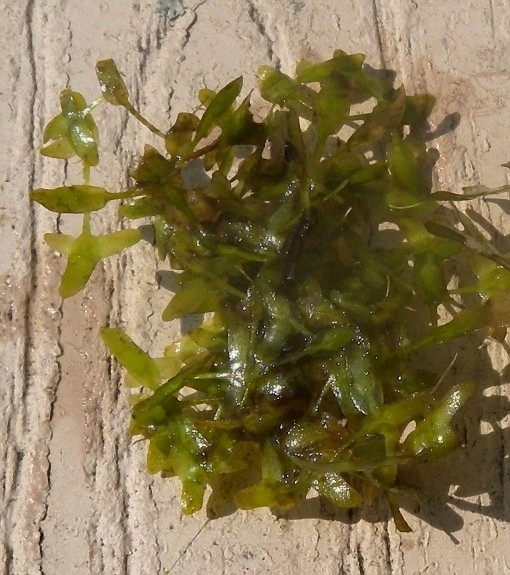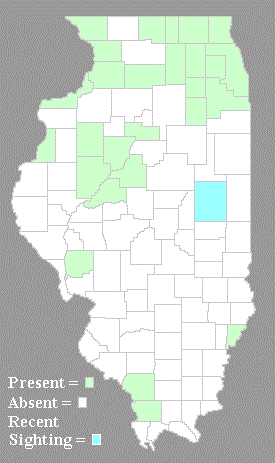
The frond is light green to dark green, or yellowish green, or reddish green, or bluish green; it is also hairless and somewhat membranous. Each frond has 3 veins (1 midvein and 2 lateral veins) that can be difficult to see. These veins originate from the node of the frond (where they are joined together at the lower-middle center of the frond); the lateral veins branch outward and curve inward until they run parallel to the midvein. On the lower side of the frond at the node, a single rootlet is sometimes produced. This rootlet is 10-25 mm. long, white, and slender; it has an unwinged basal sheath and an acute tip. A non-flowering frond reproduces asexually at its node, where a pair of new fronds develop laterally at right angles (90º) from the mother frond, pointing in opposite directions. The new fronds develop basal stalks that remain attached to the mother frond, although they may break away
 from the mother frond as they
age.
A chained network of 12-60 clonal fronds may develop during a single
growing season.
Flowering plants are monoecious, producing a single male flower and a
single female flower on the same frond from lateral pouches; these
greenish flowers are about 1 mm. across. A male flower has 1 or 2
stamens, while a female flower has a single-celled ovary. The flowers
are cross-pollinated by the wind. Afterwards, the female flowers
develop seeds. These seeds are 0.5-1 mm. long with 15-18 longitudinal
ribs.
from the mother frond as they
age.
A chained network of 12-60 clonal fronds may develop during a single
growing season.
Flowering plants are monoecious, producing a single male flower and a
single female flower on the same frond from lateral pouches; these
greenish flowers are about 1 mm. across. A male flower has 1 or 2
stamens, while a female flower has a single-celled ovary. The flowers
are cross-pollinated by the wind. Afterwards, the female flowers
develop seeds. These seeds are 0.5-1 mm. long with 15-18 longitudinal
ribs.Cultivation: The preference is full or partial sun, and slowly moving or stagnant water. The water should be clear, relatively cool, and mildly acidic to mildly alkaline (often calcareous). Like other duckweeds (Lemna spp.), this plant can reproduce itself aggressively by forming new plants from clonal offsets.
Range & Habitat: The native Star Duckweed (Lemna trisulca) is occasional in northern Illinois and some areas of central Illinois, while in the rest of the state it is rare or absent. This plant is widely distributed in temperate areas of North America, Eurasia, and Africa. Habitats include cool springs, streams, ponds, marshes, fens, and pools of water in woodlands. Star Duckweed is found primarily in average to high quality natural areas.
Faunal Associations: Various insects, turtles, wetland birds (primarily ducks), and freshwater fish feed on duckweeds (Lemna spp.). This includes such insects as the Rhopalosiphum nymphaeae (Waterlily Aphid), Tanysphyrus lemnae (Duckweed Weevil), frond-mining larvae of Lemnaphila scotlandae (an Ephydridid fly), larvae of Munroessa icciusalis (Pondside Moth), larvae of Neocataclysta magnificalis (Scrollwork Moth), larvae of Synclita obliteralis (Waterlily Leafcutter Moth), and larvae of Synclita tinealis (Black Duckweed Moth); see Harms & Grodowitz (2009) and Covell (1984/2005). These small aquatic plants are also a source of food for Chelydra serpentina (Snapping Turtle), Chrysemys picta (Painted Turtle), Emydoidea blandingii (Blanding's Turtle), Graptemys ouachitensis (Ouachita Map Turtle), Kinosternum flavescens (Yellow Mud Turtle), and Trachemys scripta (Slider); see Ernst et al. (1994). Wetland birds feeding on these plants include the Wood Duck, Northern Pintail, Green-winged Teal, Blue-winged Teal, Ring-necked Duck, Ruddy Duck, Trumpeter Swan, Common Coot, and Sora (see the Bird Table for a more complete list of these species). In addition, these small aquatic plants are a source of food for many species of freshwater fish, including the Smallmouth Buffalo, Bigmouth Buffalo, River Redhorse, Common Carp, Channel Catfish, and Pumpkinseed (see the Fish Table for a more complete list of these species). Star Duckweed (Lemna trisulca) provides protective cover from many kinds of small aquatic organisms, insects, minnows, tadpoles, and other wetland wildlife.

Photographic Location: A marsh near Volo Bog in Lake County, Illinois.
Comments: Because of its distinctive shape, long basal stalks, and relatively large size, this duckweed (Lemna sp.) is easy to identify. It often grows with other duckweeds and aquatic liverworts (e.g., Riccia fluitans and Ricciocarpus natans) in cool clear water. Other common names of Lemna trisulca include Ivy-leaved Duckweed and Submerged Duckweed.